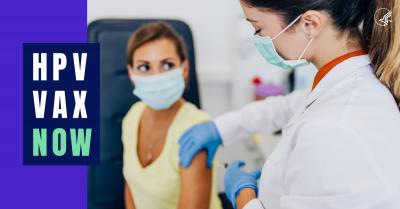OWH Blog: Knowledge and News on Women (April 2021)
April 1, 2021
This April, we recognize National Young Adult Cancer Awareness Week, which aims to highlight issues surrounding cancer for young people under the age of 40. One in four Americans — or nearly 80 million people — are infected with human papillomavirus, or HPV, and most are in their late teens or early 20sBoersma, P & Black, L. 2018. Human Papillomavirus Vaccination Among Adults Aged 18−26, 2013−2018. NCHS Data Brief No. 354, January 2020. HPV infections cause about 36,000 cases of cancer, including cancers of the cervix, vagina, penis, vulva, anus, and throat, as well as pre-cancerous lesions of the cervix and anus. The good news is that the HPV vaccine could prevent 90% of these cancers and pre-cancerous lesions from developing, especially in young adults.
According to the U.S. Centers for Disease Control and Prevention (CDC), only about 50% of young women and about 20% of young men have received the HPV vaccine. To improve HPV vaccination rates, the U.S. Department of Health and Human Services (HHS), Office of the Assistant Secretary for Health (OASH), Office on Women’s Health (OWH) launched the HPV VAX NOW campaign. “We are sharing information about the HPV VAX campaign to enhance awareness about this very important topic, which can help men and women live healthier lives,” said Kaveeta P. Vasisht, M.D., Pharm.D., FDA Associate Commissioner for Women’s Health.
The campaign targets young men and women ages 18 to 26 and healthcare providers in Mississippi, South Carolina, and Texas, states with HPV vaccination rates below the national average of 54.2%HPV Vaccination Among Young Adults: Information for Healthcare Providers (2021, January) VACCINES.GOV https://www.vaccines.gov/get-involved/spread-the-word/toolkits/hpv-vaccine-promotional-toolkit/healthcare/provider.
The purpose of the campaign is to increase awareness of the risk for HPV-related cancers and the protective benefits of the HPV vaccine and to empower young men and women to receive all recommended doses. The campaign also supports healthcare providers who counsel young adults by offering tips on how to effectively recommend the vaccine.
The CDC recommends the HPV vaccine for men and women through age 26 who were not vaccinated as children. While the vaccine is most effective when administered during adolescence, evidence has consistently shown its benefit in preventing cancer and pre-cancerous lesions when given to young adults. Among women who were vaccinated against HPV between ages 17 and 30, there was a 53% decrease in risk of invasive cervical cancerHPV Vaccination Among Young Adults: Information for Healthcare Providers (2021, January) VACCINES.GOV https://www.vaccines.gov/get-involved/spread-the-word/toolkits/hpv-vaccine-promotional-toolkit/healthcare/provider. Unfortunately, less than 40% of young adults in the United States have received one or more doses of the HPV vaccine, and only 22% have been fully vaccinatedBoersma, P & Black, L. 2018. Human Papillomavirus Vaccination Among Adults Aged 18−26, 2013−2018. NCHS Data Brief No. 354, January 2020. Thus, the HPV VAX NOW campaign’s focus on young adults is an important strategy to prevent HPV-related cancers.
“I encourage young adults who have not received the HPV vaccine to talk to their healthcare providers,” said Dorothy Fink, M.D., Deputy Assistant Secretary for Women’s Health. “Along with healthcare providers, local pharmacies, on-campus student health centers, federally qualified health centers, and local health departments also may offer the HPV vaccine.”
Young adults can find more information about the HPV vaccine on the HPV VAX NOW campaign webpage for young adults. Healthcare providers can find guidance and tips to increase vaccination among their young-adult patients in this vaccine toolkit.


